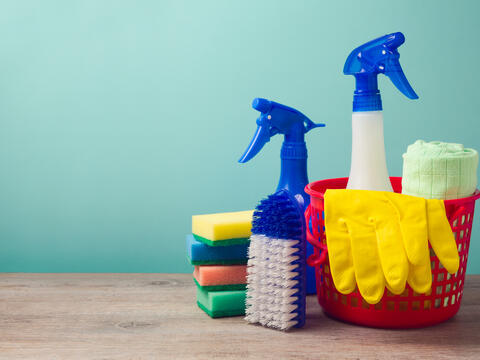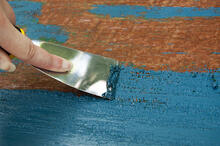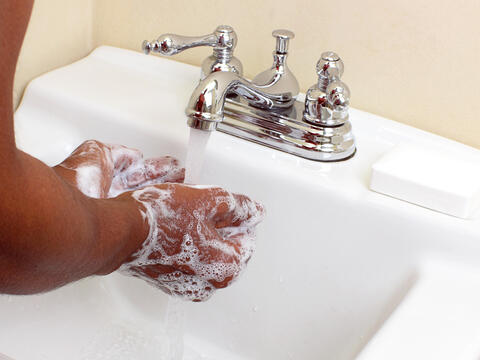Lead-Safe Wisconsin: How to Make Your Home Lead-Safe
Lead safety starts at home
Lead exposure is a serious health risk, especially for young children. Lead can be found in homes built before 1978, particularly in paint, dust, soil, and plumbing. While you can't always see, smell, or taste lead, the health impacts are real.
Learn more about lead poisoning
Do you live in a home built before 1978?
If you have chipping and peeling paint, the Lead-Safe Homes Program may be able to help.
On this page
- Understand where lead comes from
- Keep your home clean
- Hire a Lead-Safe Renovator
- Practice good hygiene
- Use safe water for drinking and cooking
- Support your child with healthy food
- Test your child for lead
- Get support
Understand where lead comes from
Lead is most often found in:
- Paint and dust in homes built before 1978.
- Soil near old buildings or roadways.
- Plumbing materials and water service lines.
- Some imported products like pottery, spices, toys, and cosmetics.
Learn more about where lead hides and how to spot hazards, visit Sources of Lead.
Keep your home clean
Chipping, peeling paint and lead dust are two of the biggest sources of lead exposure in the home. A clean home is key to reducing lead exposure. This is especially true in older homes where lead-based paint or dust may be present. When you clean well, it stops lead from building up on surfaces where children eat, play, and crawl.
What to focus on
Lead dust can hide anywhere in your home, but there some places with higher risks. When cleaning, make sure you focus on:
Floors.
Young children spend a lot of time crawling, playing, and sitting on the floor. Lead dust naturally settles downward, so floors frequently expose children to lead.
Windowsills and wells.
Friction from opening and closing windows can grind lead-based paint into a fine dust. Window wells and sills often collect this dust. It can then get onto children's hands, toys, and nearby surfaces. Wipe these areas down often with disposable wet wipes.
Baseboards and trim.
These areas are often coated in old paint, which can chip or wear down. Since baseboards are at child level, kids may touch or mouth them without you realizing. Keep a close eye on peeling or damaged paint. Clean these surfaces regularly to prevent dust buildup.
Toys and surfaces children touch often.
Even if a surface doesn't appear dusty, lead can still be present in trace amounts. Children often put their hands and toys in their mouths. This makes these objects a major source of exposure. Wash your children's toys frequently, especially those used on the floor or outside.
Cleaning do's and don'ts
| Do | Don't |
|---|---|
| Do use disposable wet wipes to clean floors, windows, entryways, and exposed surfaces. | Don't sweep or dust, these actions spread lead dust into the air. |
| Do wash your rags and mop heads separately from your clothes and other items after using them to clean. | Don't reuse dirty clothes without washing them first. |
| Do use a HEPA vacuum if you must vacuum an area. | Don't use a standard vacuum. This can blow lead dust back into the air. |
| Do clean window wells and sills with disposable wet wipes at least weekly. | Don't ignore paint chips or built-up dust in windows. |
| Do wash toys, formula bottles, and high-touch surfaces often. | Don't let children chew on painted surfaces or windowsills. |
| Do use wet cleaning supplies that can be thrown away, such as disposable wet wipes. | Don't pour dirty water down the toilet if it could contain lead. |
| Do use a mat or tray at your entryway and take off your shoes. | Don't track dirt inside. |
Extra tips for safe cleaning
To avoid lead exposures, it's important clean effectively.
Start high, clean low.
Begin with higher surfaces like counters and shelves. Then, work your way to the floor to avoid recontamination.
Use disposable wet wipes.
Avoid spreading dust from one surface to another. It is no longer suggested to mop or Swiffer. Never dump dirty mop water down the toilet if it could contain lead.
Update your cleaning routine.
Increase cleaning if you renovate or live in a building with ongoing construction.
Hire a Lead-Safe Contractor
Renovation work can release dangerous levels of lead dust in homes built before 1978. This includes any time you plan to repair, paint, or disturb old surfaces. When doing this work, it's important to hire a certified lead-safe contractor.
Learn more about hiring a lead-safe contractor with our step-by-step guide:
Learn how to hire a lead-safe contractor
What types of work can create lead hazards?
- Sanding or scraping painted surfaces.
- Replacing windows or doors.
- Demolishing walls or ceilings.
- Repairing or disturbing old pluming.
Why hire a certified lead-safe renovator?
- They know how to contain dust, clean safely, and protect your family.
- They use specialized tools, barriers, and cleanup procedures that prevent lead from spreading.
Hiring a certified professional is required by law for certain types of work.
Learn more on the DHS Wisconsin's Lead-Safe Renovation Rule webpage.
How to verify a contractor's certification
Request proof of certification.
Ask the contractor to provider their current certification credentials.
Check the certified lead company list.
Wisconsin's Certification and Field Compliance Unit maintains a spreadsheet of certified lead companies. Find it here: Certified Lead Companies.
Contact DHS for assistance.
If you need help verifying a contractor's certification, you can reach out to our Certification and Field Compliance Units.
Practice good hygiene
Everyday habits can prevent children from swallowing or breathing in lead dust.
Remind children to wash their hands frequently.
This is most important to do before eating and sleeping, and after playing.
Clean toys, bottles, and pacifiers often
Especially if they've been on the floor.
Cover bare soil in play areas.
Cover soil with mulch, grass, or sand.
Play in the grass.
Limit your child's contact with bare soil.
Use safe water for drinking and cooking
Lead in water typically comes from old plumbing, pipes, or fixtures. Learn more about lead-in-water on our Sources of Lead page. To protect your family from lead-in-water:
- Use only cold water for drinking, cooking, or preparing baby formula.
- Run your tap for 30 seconds to two minutes if the water hasn't been used for several hours, such as overnight.
- Consider using a certified water filter that removes lead. Always use a directed.
- For information on safe water filters, visit the NSF website on Certified Lead Reduction Products
- Contact your local water utility with concerns about city water pipes and laterals.
Support your child with healthy food
A healthy diet can help reduce how much lead the body absorbs. Certain nutrients make it harder for lead to stay in the body. Make sure your child's diet includes:
Iron-rich foods
- Beans
- Eggs
- Fortified cereals
- Lean meats
- Spinach
Calcium-rich foods
- Milk
- Yogurt
- Cheese
- Leafy greens
Vitamin C-rich foods
- Oranges
- Strawberries
- Bell peppers
- Tomatoes
Serve regular meals and snacks. An empty stomach absorbs more lead. Keeping children well-fed can lower the risk of lead poisoning.
Get your child tested for lead
In most cases, children with lead poisoning don't show symptoms until it is too late. The only way to know for sure if a child has been exposed to lead is through a blood test.
Wisconsin recommends:
- All children should be tested at 12 and 24 months of age.
- Children between age 3 and 5 should also receive a blood test if they have not been tested before.
To learn more, visit our webpage about testing your child's blood for lead.
Get support
If you're concerned about lead in your home, help is available. Wisconsin residents may qualify for free or low-cost services through the Lead-Safe Homes Program. This program offers testing, repairs, and abatement.
Explore more:



